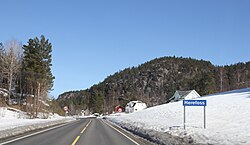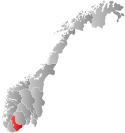Herefoss (municipality)
Former municipality in Aust-Agder, Norway From Wikipedia, the free encyclopedia
Herefoss is a former municipality in the old Aust-Agder county in Norway. The municipality existed from 1838 until its dissolution in 1967 when it was merged into Birkenes municipality in what is now Agder county. Herefoss was a 148-square-kilometre (57 sq mi) area surrounding the Herefossfjorden (part of the river Tovdalselva). The administrative centre was the village of Herefoss where the Herefoss Church is located. The other main village was Søre Herefoss, located in the southern part of the municipality.[2]
Herefoss Municipality
Herefoss herred | |
|---|---|
| Hegrefoss herred (historic name) | |
 View of the village of Herefoss | |
 Aust-Agder within Norway | |
 Herefoss within Aust-Agder | |
| Coordinates: 58.5243°N 08.3511°E | |
| Country | Norway |
| County | Aust-Agder |
| Established | 1 Jan 1838 |
| • Created as | Formannskapsdistrikt |
| Disestablished | 1 Jan 1967 |
| • Succeeded by | Birkenes Municipality |
| Administrative centre | Herefoss |
| Area (upon dissolution) | |
• Total | 148 km2 (57 sq mi) |
| Population (1967) | |
• Total | 585 |
| • Density | 4.0/km2 (10/sq mi) |
| Time zone | UTC+01:00 (CET) |
| • Summer (DST) | UTC+02:00 (CEST) |
| ISO 3166 code | NO-0933[1] |
History
Summarize
Perspective
The municipality of Heirefos was established on 1 January 1838 (see formannskapsdistrikt law). In 1900, 610 people lived in the municipality on 67 different farms. During the 1960s, there were many municipal mergers across Norway due to the work of the Schei Committee. On 1 January 1967, Herefoss (population: 585) was merged with the neighboring municipalities of Birkenes (population: 1,883) and Vegusdal (population: 582), forming the new municipality of Birkenes with its administrative centre located at Birkeland.[3]
Herefoss was historically the seat of public officials in this region. The fogd resided here from 1680 to 1820, and the sorenskriver (district judge) also lived here from 1724 to 1852. Herefoss was established as a prestegjeld in 1875. Herefoss Church was consecrated by Bishop Jacob von der Lippe in 1865.[citation needed]
Name
The municipality (originally the parish) is named after the old Herefoss farm (Old Norse: Hegrafors) since the first Herefoss Church was built there. The first element is the name of the local river, Hegra. This name is derived from the word hegri which means "heron", likely the grey heron which inhabits the area. The last element is fors which means "waterfall".[4] Historically, the name of the municipality was spelled Hegrefoss. On 3 November 1917, a royal resolution changed the spelling of the name of the municipality to Herefoss.[5]
Government
Summarize
Perspective
While it existed, this municipality was responsible for primary education (through 10th grade), outpatient health services, senior citizen services, unemployment, social services, zoning, economic development, and municipal roads. During its existence, this municipality was governed by a municipal council of directly elected representatives. The mayor was indirectly elected by a vote of the municipal council.[6]
Municipal council
The municipal council (herredsstyre) of Herefoss was made up of 13 representatives that were elected to four-year terms. The tables below show the historical composition of the council by political party.
| Party name (in Norwegian) | Number of representatives | |
|---|---|---|
| Labour Party (Arbeiderpartiet) | 6 | |
| Christian Democratic Party (Kristelig Folkeparti) | 2 | |
| Centre Party (Senterpartiet) | 4 | |
| Liberal Party (Venstre) | 1 | |
| Total number of members: | 13 | |
| Party name (in Norwegian) | Number of representatives | |
|---|---|---|
| Labour Party (Arbeiderpartiet) | 6 | |
| Christian Democratic Party (Kristelig Folkeparti) | 3 | |
| Centre Party (Senterpartiet) | 4 | |
| Total number of members: | 13 | |
| Party name (in Norwegian) | Number of representatives | |
|---|---|---|
| Labour Party (Arbeiderpartiet) | 5 | |
| Christian Democratic Party (Kristelig Folkeparti) | 4 | |
| Farmers' Party (Bondepartiet) | 4 | |
| Total number of members: | 13 | |
| Party name (in Norwegian) | Number of representatives | |
|---|---|---|
| Labour Party (Arbeiderpartiet) | 5 | |
| Christian Democratic Party (Kristelig Folkeparti) | 2 | |
| Farmers' Party (Bondepartiet) | 5 | |
| Total number of members: | 12 | |
| Party name (in Norwegian) | Number of representatives | |
|---|---|---|
| Labour Party (Arbeiderpartiet) | 5 | |
| Christian Democratic Party (Kristelig Folkeparti) | 3 | |
| Farmers' Party (Bondepartiet) | 4 | |
| Total number of members: | 12 | |
| Party name (in Norwegian) | Number of representatives | |
|---|---|---|
| Labour Party (Arbeiderpartiet) | 6 | |
| Farmers' Party (Bondepartiet) | 4 | |
| Joint list of the Liberal Party (Venstre) and the Radical People's Party (Radikale Folkepartiet) | 2 | |
| Total number of members: | 12 | |
| Party name (in Norwegian) | Number of representatives | |
|---|---|---|
| Labour Party (Arbeiderpartiet) | 5 | |
| Farmers' Party (Bondepartiet) | 4 | |
| Liberal Party (Venstre) | 3 | |
| Total number of members: | 12 | |
| Note: Due to the German occupation of Norway during World War II, no elections were held for new municipal councils until after the war ended in 1945. | ||
See also
References
Wikiwand - on
Seamless Wikipedia browsing. On steroids.
